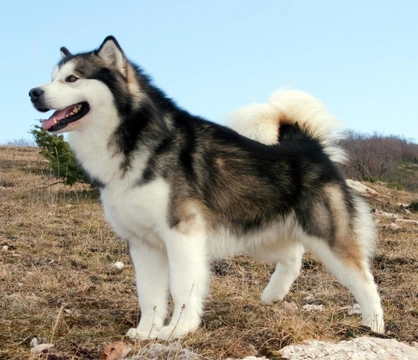
Why the Alaskan malamute is so well suited to work in cold weather
The Alaskan malamute is one of the most outgoing, energetic and lively of all dog breeds, and they are also smart dogs with a strong streak of mischief! Originally used as sled dogs in Alaska, one of the coldest and most inhospitable areas of the world, the Alaskan malamute is one of the oldest breeds of dog extant today, and over their history, they have evolved and adapted to suit their native environment and subsequent work alongside of man.
It is the breed’s combination of physical and temperamental traits that makes them so well suited to living in cold, harsh climates and being able to work effectively in such places – and in this article, we will break down the various elements of the Alaskan malamute’s conformation and temperament to explain exactly why they are such good working dogs in cold climates. Read on to learn more.
The Alaskan malamute coat
As you might expect from a cold weather dog breed, the Alaskan malamute’s coat is perfectly designed to keep them warm and protected. The top layer of the coat is very coarse and thick, protecting a warming, insulated undercoat that is soft and dense and designed to hold heat, while the guard hairs in the top layer of the coat keep out the wind, rain and snow.
The Alaskan malamute is also very adaptive in terms of their coats, and as soon as the seasons start to change, they will begin to shed heavily and grow in their new coat for the coming season, losing some of the fluffy undercoat in the summer and growing it back in earnest when autumn comes around!
Efficient digestion
Feeding an Alaskan malamute properly can be expensive, as this is a large and muscular dog breed that in turn, needs a lot of food! However, when it comes to the size of the dog in comparison to how much food they need, the malamute is actually comparatively economical to feed, and they have a very efficient digestive system that allows them to gain the maximum nutrients from their meals and convert this to useful energy.
This is important for working Alaskan malamutes, who are often on the go working hard all day between meals.
The paws
The paws of the Alaskan malamute are proportionally large compared to the body, and have dense fur running right along the leg covering the top of the foot, as well as thick clumps of fur between the toes too. This additional fur helps to insulate and protect the feet against snow and other cold, harsh surfaces, reducing body heat lost through the feet and helping the dog to walk on snow or other infirm surfaces.
Eyes and ears
The surface area of the malamute’s ears is rather small compared to the size of the dog, which again, helps to reduce heat lost and so, calories burned. The ears are triangular and upright, which allows the dog to move them back and fore to let them tune in to quiet or distant sounds. They are also very hairy and densely furred around the entrance to the ear, to keep out the cold and snow.
The eyes of the Alaskan malamute are relatively small and surrounded by plush fur, which again, helps to keep snow out of the eyes and allow the dog to see where they are going even in the middle of a storm!
Pack mentality
Alaskan malamutes are highly social dogs that love the company of others, and that work at their best as part of a pack. The fact that the breed is so outgoing and lively makes them well matched to living and working alongside of others, and when working as a pack, the dogs support each other and combined, produce higher speeds and better endurance than each dog alone would be able to manage comparatively.
High energy levels and endurance
The Alaskan malamute is a very lively dog that naturally needs to spend a lot of time on the move playing and exercising. Within a domestic setting, they need long, varied daily walks and the ability to play and run freely off the lead, which can be a challenge to provide for people who keep livelier malamutes as pets.
Not only are dogs of the breed very lively and capable of running very fast, but they also have excellent endurance, and turn their food into slow-release fuel for energy, to support them for a whole day on the go.
Their combination of good musculature, long legs and plenty of stamina enables them to move quickly over the ground, and retain enough reserves of energy to keep going for several hours at a time. The muscles of the shoulders provide the malamute with the strength that they need to pull a sled, and their movements and gait enable them to move at the most efficient speed to make the most of their energy reserves.



